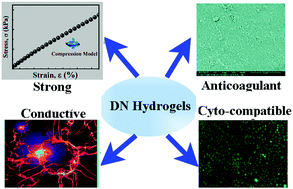Highly hemo-compatible, mechanically strong, and conductive dual cross-linked polymer hydrogels†
Abstract
A new class of hydrogels distinguished by electro-conductivity and high hemo-compatibility, which resemble biological tissues, are promising candidates for a plethora of biomedical applications. This work describes the design of highly elastic and biocompatible hydrogels using polypyrrole (PPy) as the conductivity media. The bio-inspired design of heparin-mimicking sodium alginate (HMSA) combined with tough alginate/polyacrylamide (PAM) is selected to form chemical and physical cross-linked binary hydrogel networks, while the incorporation of interfacial polymerized PPy endows the hydrogels with electro-conductivity. The resulting hydrogels exhibit a mesh-like hierarchical structure with excellent mechanical strength; moreover, the hydrogels show greatly enhanced electro-conductivity (up to 0.63 S m−1). In addition, due to the presence of the unique heparin-mimicking structure, the hydrogels possess a desirable anticoagulant ability and biocompatibility demonstrated via antithrombotic evaluations together with cell culture observations. The facile synthesis of HMSA/PAM/PPy hydrogels and their robust physical, chemical and biological performance make them attractive components for the future generation of biosensors and bioelectrodes.


 Please wait while we load your content...
Please wait while we load your content...